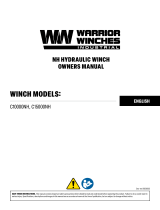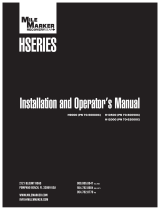13
WINCH PARTS LIST
No. Part # Qty Description Remark
1 C100NH0100 1 Hydraulic Motor Used in C10000NH
C150NH0100 1 Hydraulic Motor Used in C15000NH
2 C100NH0001 2 Screw M12×30
3 C100NH0002 2 Lock Washer Ø12
4 C100NH0003 4 Screw M8×25
5 C100NH0004 4 Lock Washer Ø8
6 C100NH0005 1 Coupling plate
7 C100NH0006 1 Front Bearing Used in C10000NH
C150NH0006 1 Front Bearing Used in C15000NH
8 C100NH0007 2 Bushing-Drum Used in C10000NH
C150NH0007 2 Bushing-Drum Used in C15000NH
9 C100NH0200 1 Break/Shift Assembly Used in C10000NH
C150NH0200 1 Break/Shift Assembly Used in C15000NH
10 C100NH0008 1 Transition Shaft
11 C100NH0300 1 Drum Assembly Used in C10000NH
C150NH0300 1 Drum Assembly Used in C15000NH
12 C100NH0009 1 Screw M8×10
13 C100NH0010 1 Inner supporting Used in C10000NH
C150NH0010 1 Inner supporting Used in C15000NH
14 C100NH0011 1 “O” Ring Seals Used in C10000NH
C150NH0011 1 “O” Ring Seals Used in C15000NH
15 C100NH0012 1 Gear-Ring Used in C10000NH
C150NH0012 1 Gear-Ring Used in C15000NH
16 C100NH0400 1 Gear Carrier Assembly(Output) Used in C10000NH
C150NH0400 1 Gear Carrier Assembly(Output) Used in C15000NH
17 C100NH0500 1 Gear Carrier Assembly(Intput) Used in C10000NH
C150NH0500 1 Gear Carrier Assembly(Intput) Used in C15000NH
18 C100NH0013 1 Transmission Shaft
19 C100NH0014 1 Antifriction Pad
20 C100NH0015 1 Screw M8×10
21 C100NH0600 1 Clutch handle Assembly
22 C100NH0016 1 Gear-Housing
23 C100NH0002 4 Lock Washer Ø12
24 C100NH0017 4 Screw M12×35
25 C100NH0018 4 Tamper
26 C100NH0019 4 Screw M10×35
27 C100NH0020 2 Tie Bar
28 C100NH0021 4 Lock Washer Ø10
29 C100NH0700 1 Tensioned Of Steel Wire Supplied Assembly
30 C100NH0021 4 Lock Washer Ø10
31 C100NH0022 4 Screw M10×25
32 C100NH0023 1 Back Mounting Plata
33 C100NH0002 4 Lock Washer Ø12
34 C100NH0024 4 Screw M12×30
35 C100NH0800 1 Cable Assembly Used in C10000NH
C150NH0800 1 Cable Assembly Used in C15000NH




















